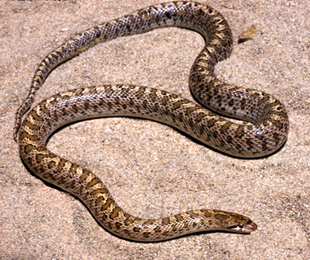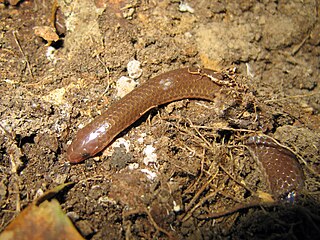
The desert kingsnake is a species of kingsnake native to Texas, Arizona, and New Mexico, United States. It is not venomous, colored yellow and black. The desert kingsnake's diet consists of rodents, lizards, and smaller snakes, including rattlesnakes. They normally grow 3–4 ft long, but have been known to grow up to 6.8 ft. They are docile creatures when confronted by humans. If they do not try to escape, often they "play dead" by flipping over onto their backs and lying motionless. Some who domesticate kingsnakes, such as ranchers, do so in the hopes that the kingsnakes will feed on other snakes, which might present more of a threat. It was previously considered a subspecies of the common kingsnake. The desert kingsnake belongs to the Colubridae family, which is the largest family of snakes in the world.

Arizona elegans is a species of medium-sized colubrid snake commonly referred to as the glossy snake or the faded snake, which is endemic to the southwestern United States and Mexico. It has several subspecies. Some have recommended that A. elegans occidentalis be granted full species status.

Gyalopion is a genus of small nonvenomous colubrid snakes. Species in the genus Gyalopion are commonly referred to as hooknose snakes, and are native to the southwestern United States and Mexico.

Vipera ammodytes is a viper species found in southern Europe, mainly northern Italy, the Balkans, and parts of Asia Minor. Like all other vipers, it is venomous. It is reputed to be the most dangerous of the European vipers due to its large size, long fangs and high venom toxicity. The specific name, ammodytes, is derived from the Greek words ammos, meaning "sand", and dutes, meaning "burrower" or "diver", despite its preference for rocky habitats. Five subspecies are currently recognized, including the nominate subspecies described here.

Crotalus viridis nuntius is a venomous pit viper subspecies native primarily to the desert plateau of the northeastern portion of the American state of Arizona, but also ranges into northwestern New Mexico. Named for the Native American Hopi tribe, which inhabits the region, its range overlaps that of the nominate subspecies and some interbreeding is believed to occur. The taxonomy of the C. viridis group is a matter of debate, many considering the various subspecies to be nothing more than locality variations.

The smooth earth snake is a species of nonvenomous natricine colubrid snake native to the eastern half of the United States.

Arizona elegans philipi, commonly known as the Painted Desert glossy snake, is a subspecies of glossy snakes, a nonvenomous colubrid endemic to North America.

Metlapilcoatlus nummifer, commonly known as Mexican jumping pitviper or jumping viper, is a venomous pit viper species endemic to Mexico.

Bothriechis aurifer is a venomous pit viper species found in Mexico and Guatemala. No subspecies are currently recognized.

The California night snake is a subspecies of small colubrid snake native to California.

The Pacific gopher snake is a subspecies of large non-venomous colubrid snake native to the western coast of North America.

Gloydius ussuriensis is a venomous pitviper species endemic to far east Russia, northeastern China and the Korean Peninsula. No subspecies are currently recognized.

Bothrops punctatus is a venomous pitviper species found in Ecuador, Mostly in the Chocó Department in Western Colombia and Panama. No subspecies are currently recognized.

The eastern worm snake is a subspecies of the worm snake, Carphophis amoenus, a nonvenomous colubrid endemic to the Eastern Woodlands region of North America. The species' range extends from southwest Massachusetts, south to southern Alabama, west to Louisiana and north to Illinois. This species is common in the ecotone between woodlands and wetlands. It may also be found in grasslands adjacent to woodlands. Though this snake can be abundant in parts of its range, it is rarely seen because of its fossorial lifestyle. When not underground, C. a. amoenus resides mostly under rocks, logs and leaf litter, or burrowed within rotting woody debris. This snake is perfectly safe to pick up, as it cannot bite, but may produce a foul-smelling excretion.
Wyoming is home to 12 amphibian species and 22 species of reptiles.

Carphophis amoenus, commonly known as the worm snake, is a species of nonvenomous colubrid snake endemic to the eastern United States. C. amoenus can be found east of the Mississippi, from southwest Massachusetts south to southern Alabama west to Louisiana and then north to Illinois. This species of snake protects a large range, and normally prefers a moist habitat in the rocky woodlands, under rotten wood of logs and stumps. Though this snake is quite abundant over its range, it is rarely seen because of its dormant lifestyle and where it usually resides. This snake is most common on the edges or in the ecotonal areas of open to thick woodlands, and the borders of wetlands. It may also be found in the grasslands next to woodlands. The best chance to spot it is after heavy rains, when its small size and distinct color make it easy to spot. This species prefers moist soil inhabited by earthworms, which are its main prey, so the soil needs to be sufficiently moist. The snake's skin naturally evaporates water; so the soil needs to be moist enough to offset this. C. amoenus is mostly found under rocks and in sufficient leaf litter during the extreme daytime heat. Peak activity falls between 15:00 to 18:00.

Afrotyphlops schlegelii, commonly known as Schlegel's beaked blind snake or Schlegel's giant blind snake, is a species of snake in the family Typhlopidae. The species is endemic to eastern and southern Africa, and bears the distinction of being the world's largest typhlopid. It is harmless to humans and lives exclusively on a diet of termites.















